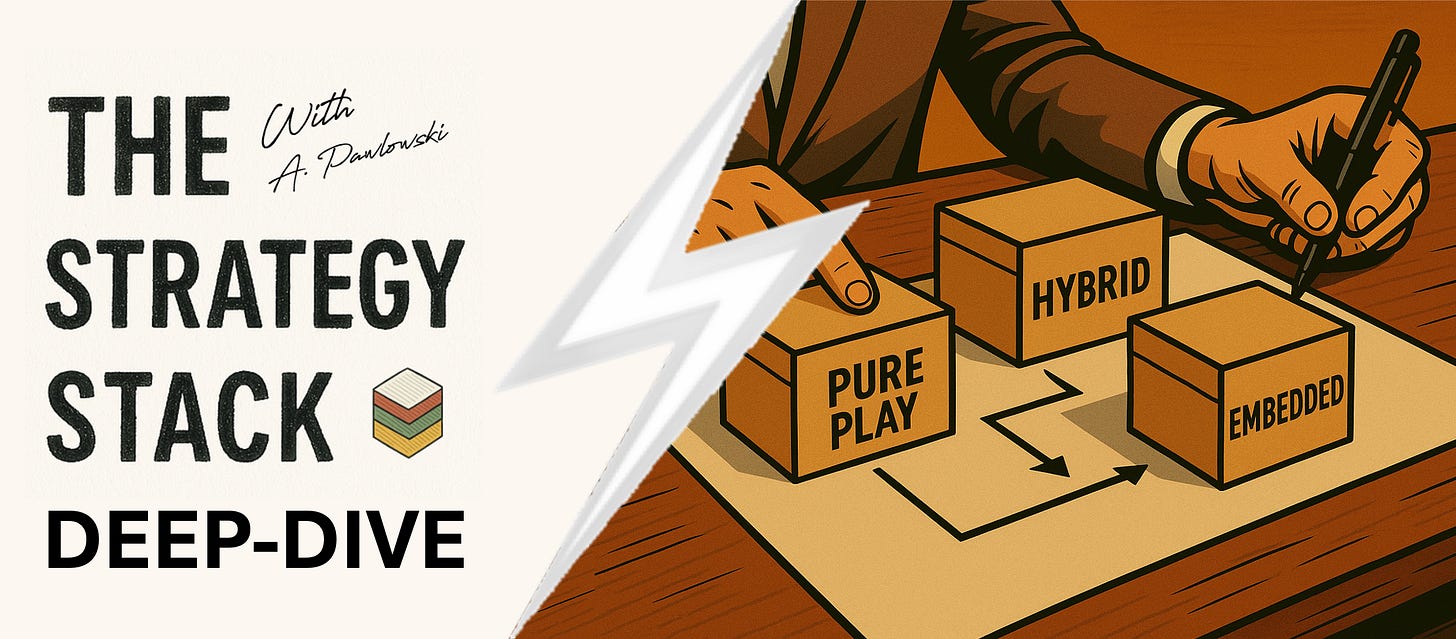Why Most Successful Business Models In 2025 Combine Multiple Archetypes
#93: 2.1 Pure Plays vs. Hybrids vs. Embedded Models
In Chapter 1, we mapped the five-layer stack of digital business models as systemic architectures. But layers are only one dimension. Another dimension is shape — the archetype a firm takes in how it creates, distributes, and captures value.
For years, strategy frameworks relied on clean categories: a SaaS firm, a marketplace, a payments processor. But by 2025, the real strategic edge lies in blending models.
Pure plays give clarity and simplicity.
Hybrids give compounding flywheels.
Embedded models give scale without visibility.
The firms that dominate don’t pick one box — they orchestrate across them.
TL;DR: Pure, Hybrid, and Embedded—The Shapes That Win in 2025
Shape matters: Beyond “layers,” the strategic edge in 2025 comes from the shape of your model—Pure Play, Hybrid, or Embedded.
Pure Plays = focus and clarity but fragile: great unit economics, easy story, yet copyable and ceiling-prone.
Hybrids = compounding flywheels: diversified revenue, cross-subsidies (e.g., AWS → Amazon retail), and data leverage—at the cost of organizational complexity.
Embedded Models = invisible scale: API-first distribution and deep lock-in with low CAC, but dependency on platforms/infrastructure.
Winning firms recombine shapes: Amazon, Shopify, Stripe, Anthropic blend pure, hybrid, and embedded elements to build resilient growth loops.
Operate on four levers: Dependencies, Leverage Points, Compounding Flywheels, Orchestration Costs.
Key takeaway: Focus alone is fragile; hybridization capacity is the moat.
Table of Contents
Strategic Insight: From Layers to Shapes
Why Shapes Matter in 2025
Pure Plays — Focused but Fragile
Definition & Advantages
Drawbacks
Examples: Zoom, Dropbox
Data Point: Pure-play SaaS margins & growth trends
Hybrids — The Compounding Flywheel
Definition & Advantages
Drawbacks
Examples: Amazon, Shopify
Data Point: Hybrid growth vs. pure-play SaaS
Embedded Models — Invisible Scale
Definition & Advantages
Drawbacks
Examples: Stripe, Anthropic
Data Point: API-first CAC vs. margin volatility
Why Hybrids (with Embedded Layers) Dominate
Operating Levers for Advantage
Dependencies (infra, distribution, monetization)
Leverage Points (cross-subsidies)
Compounding Flywheels (data → products → revenue)
Orchestration Costs (complexity tax)
Case Snapshots & Patterns
Amazon, Shopify, Stripe, Anthropic
References
1. Pure Plays — Focused but Fragile
Definition: A business operating through a single, well-defined model (e.g., SaaS subscription, e-commerce retailer).
Advantages:
Sharp unit economics.
Easy to communicate value to investors and users.
Strong execution discipline (one product, one model).
Drawbacks:
Vulnerable to copycats (Dropbox vs. Google Drive).
Plateau risk when market saturates.
No “second engine” to absorb shocks.
🔍 Examples:
Zoom (2011–2019): Pure SaaS subscription with minimal monetization flexibility.
Dropbox (pre-2016): Subscription storage without embedded ecosystem extensions.
📊 Data point: Pure-play SaaS firms in the Bessemer Cloud Index (2018–2021) averaged 40–50% YoY growth, but revenue diversification lagged. By 2023, median gross margins dropped from 75% → 69% as competition commoditized features.
Keep reading with a 7-day free trial
Subscribe to The Strategy Stack to keep reading this post and get 7 days of free access to the full post archives.


